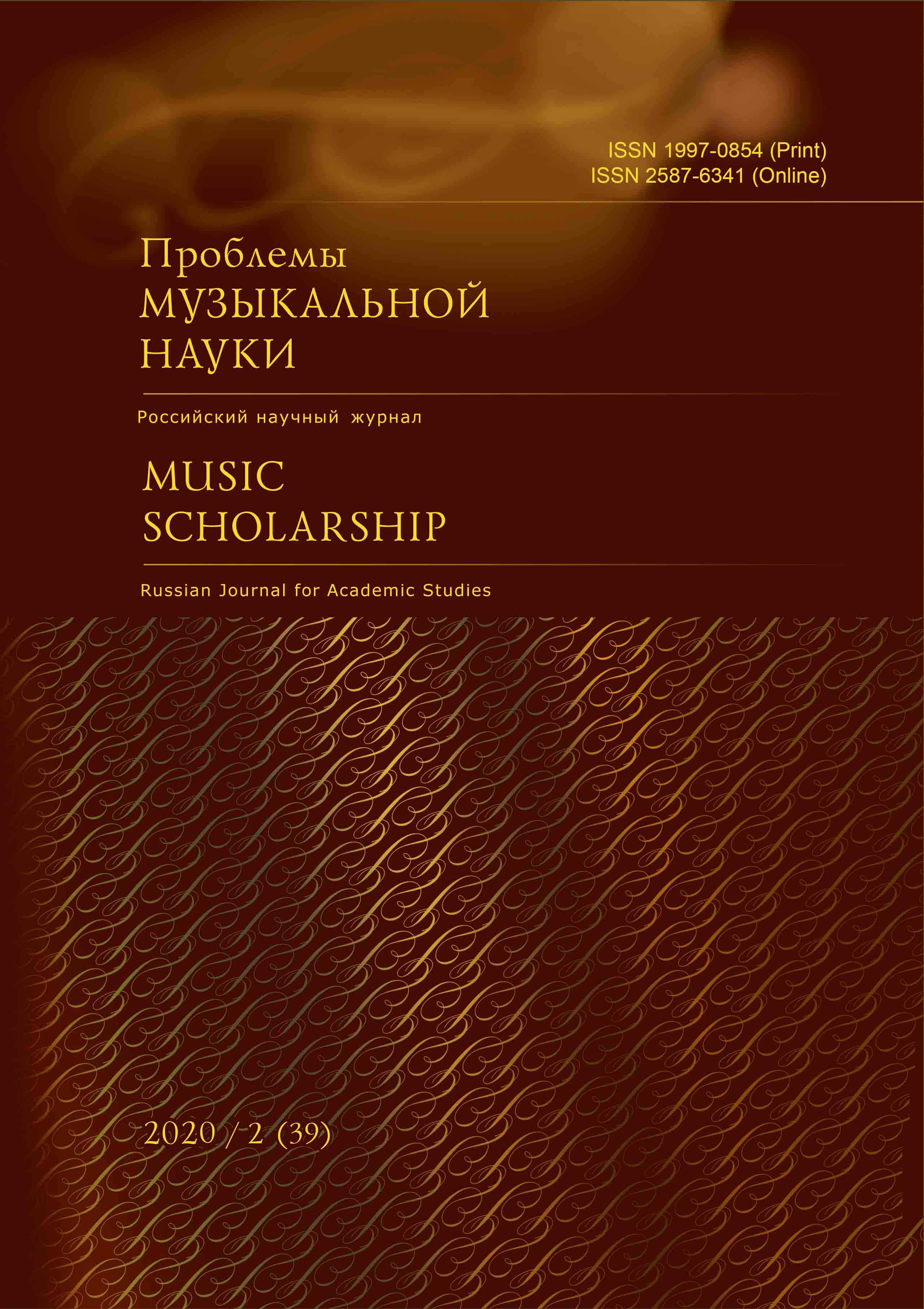The Concerto and Symphonic Principles in the Scherzo from Mahler’s Ninth Symphony
Main Article Content
Abstract
The article is devoted to the analysis of features of the concerto genre in the Scherzo from Gustav Mahler’s Ninth Symphony and the interaction of traits of the concerto and symphonic genres within the framework of Mahler’s conception of the orchestra, – the reliance on solo and chamber-like combinations of instruments (“ensembles-in-the-orchestra”). The orchestra in the Scherzo (along with harmonic and timbral differentiation) provides a most crucial means of opposition between the ländler and the waltz. The first is characterized by soloists, who represent the “protagonists,” as well as the ensembles-in-the-orchestra. The constant changes of their instrumentation manifest a scenic quality of the action and help overcome the static qualities of the numerous repetitions of the melody. The waltz, which may be interpreted as an ecstatic emotional state, depicts a peculiar generalized view of the world. This creates a sense of reliance on the group sound of the string instruments and the tutti. However, the ensembles- in-the-orchestra, appearing in concisely determined places, continue to play highly important functions: at the beginning of the first episode of the waltz they highlight the textural and timbral contrast in the manner of a concerto, while at the end of the waltz episodes they are endowed with a dramaturgical function: they interrupt the “madness” of the waltz.
The solution of the conflict becomes unexpected. It seems that the ländler gains the upper hand: fragments of familiar intonations are presented by a large number of soloists. But in reality, the richly orchestrated dance, the well-balanced ensembles and the proud-sounding melody are replaced by mere emptiness. Having profoundly transformed the ländler and the waltz in a symphonic manner within the process of development, and relying on concerto-like qualities as a perfect method of exposing the depicted inner struggle (stemming from the Latin, rather than the Italian verb concertare), Mahler reaches an extreme stage of juxtaposition, leading to the self-destruction of both elements.
Keywords: Gustav Mahler, orchestration, Mahler’s Ninth Symphony, concerto qualities, symphonic traits, Scherzo.
Article Details

This work is licensed under a Creative Commons Attribution-NonCommercial-NoDerivatives 4.0 International License.
Copyright
The rights on the results of intellectual activity and equated means of individualization are protected in accordance with Part IV of the Civil Code of the Russian Federation. The authorship, author's name, executor’s name, inviolability of the work and result of execution are protected by the rules of Part IV of the Civil Code of the Russian Federation of the author or executor, regardless of providing legal protection of such results of intellectual activity at the time of their forming.
Copyright laws regulate the civil legal relations for using works of science, literature and art. Such relationships are formed as the result of the author’s writing his or her texts. In this case the author can rightfully claim copyright of the work.
The author has certain rights to reuse the work (see: “Ethical Aspects in Terms of Multifold Publications).
Licenses
All copyrights on the articles belong to their authors. The author transfers the rights on using the article the publisher.
PDF versions of scholarly articles of the journal PMN are published by using the license Attribution Non-Commercial No Derivatives cc by-nc-nd, allowing loading and distributing works on the assumption of indicating the authorship. The works may not be changed in any way or used for commercial interests.
Criteria for Authorship, Co-authorship
The term “author” refers to all persons (co-authors) who have made a substantial contribution to conducting the research and creation of the manuscript and responsible for its content. The person (author) who has submitted the manuscript to the editorial board shall bear responsibility for the complete list of the group of authors and the changes made to the manuscript in accordance with the results of the peer reviewing and editing.
1. Authorship is based on the following criteria:
1) The author made a substantial contribution to the research activity and development of concept, collected the data, made analysis and interpretation of the data.
2) The author carried out the writing of the text of draft articles and edited it attentively and substantially.
3) The author approved the final version of the article prior to its submission.
4) The author bears responsibility for the integrity of all parts of the manuscript.
2. The authors shall guarantee that the submitted manuscript is the original work.
3. Scholarly reviews for some issue or other should be objective, present material in a wide range and at the same time take into account the views of the author of the review.
4. The authorship of scholarly publications is obligated to reflect accurately the contribution of individuals to the research activity, with specific information about the authors.
5. The authors may not mislead the readers by publishing acknowledgements of gratitude to people who were not actually involved in writing the work. Other persons who made contribution to the work, but are nevertheless not the authors, may be listed in the rubric of “Acknowledgements,” with indications of the type and extent of their activities.
6. Authors are obligated to provide a description of their contribution to the publication.
7. The order of authorship must be a joint resolution of co-authors. The authors should be ready to explain the order of their enumeration and listing.
8. The authors shall be entirely responsible for the correct definition of authorship acting in accordance with the rules adopted in their institution.
9. Investigators must ensure that only those persons who meet the criteria for authorship (that made a significant contribution to the work), shall be considered the authors, and the researchers who do not merit authorship will be excluded from the list of authors.

